Having had field experience with both Primary Arms (PA) and Vortex LPV scopes, I found that a comparison was appropriately due.
I specifically compare the Primary Arms GLx 1-6x24 FFP VS Vortex Strike Eagle 1-8x24 FFP low power variable optics (LPVO).
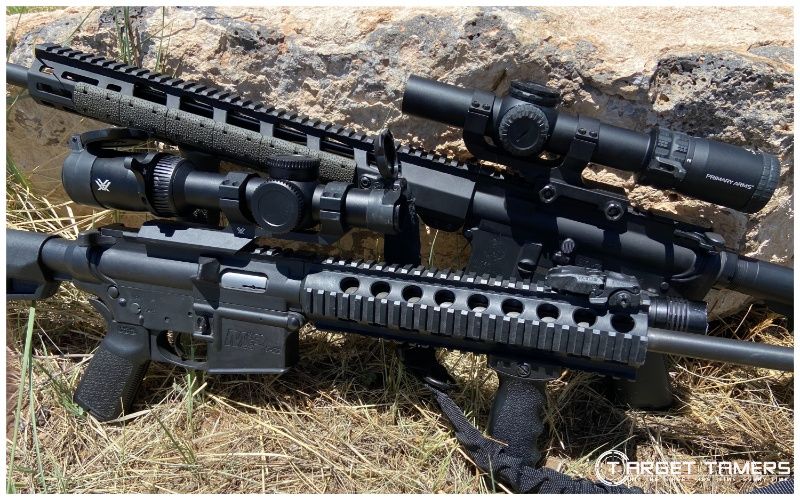
Though equivalent in price point, there are plenty of differences between the two.
I weigh up and determine which does it better when it comes to reticle, eye relief, illumination, accessories, and more.
Read on to see how they stack up!
Quick Comparison Overview & Table
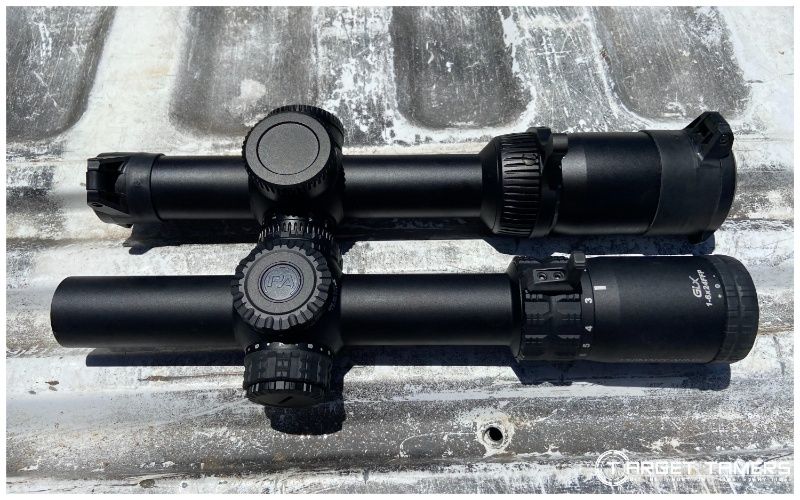
Overall, the main differences between the Vortex Strike Eagle (SE) and the Primary Arms GLx are the illuminated reticle, adjustment value, and turret type. Though both have reticles in the first focal plane scope (FFP), fixed parallax, and similar dimensions, but they’re different enough to highlight contrasts within the LPV market.
By the way, if you want to check out either of these optics in more depth, you can read my full hands-on reviews here:
| Features | Primary Arms GLx 1-6x LPVO | Vortex Strike Eagle 1-8x LPVO |
|---|---|---|
| Price Range | Under $600 | Under $600 |
| Configuration | 1-6x 24 mm | 1-8x 24 mm |
| Reticle | ACSS Raptor M6 | EBR-8 MOA |
| Focal Plane | FFP | FFP |
| Eye Relief | 3.5-3.3” | 3.9” |
| Field of View | 104.7-18.3 ft/100 yards | 113.6-14.1 ft/100 yards |
| Parallax | Fixed @ 100 yards | Fixed @ 125 yards |
| Adjustment Value | 0.1 MIL | 0.25 MOA |
| Turret Type | Capped & exposed | Capped |
| Illumination Settings | 10 DL | 9 DL / 2 NV |
| Battery Type | CR2032 | CR2032 |
| Dimensions | 10.25” L | 10.4” L |
| Weight | 21.3 oz | 24 oz |
| Waterproof | Yes | Yes |
| Lens Caps | No | Flip-up caps |
| Throw Lever | Removeable power fin | Band/ring throw lever |
| Special Features | AutoLive & configurable turrets | Sunshade included |
Why Trust Me?
After hundreds of hours of hand-testing rifle scopes in the field and on the hunt, and thousands more hours researching, writing, photographing and creating videos about them, I feel I have earned the title of expert when it comes to optics!
Optics are not just my passion, but also my full-time job!
I get my hands on as many of the optics I test as possible (through buying, borrowing or begging!) and run them through their paces to make sure they will perform out in field.
Check out our optics testing process here.
Over a decade of experience hunting, competition and target shooting has been integral in putting together this Primary Arms GLx 1-6x VS Vortex Strike Eagle 1-8x comparison.
Feature Comparisons of the Primary Arms GLx 1-6x FFP VS Vortex Strike Eagle 1-8x FFP
Cost
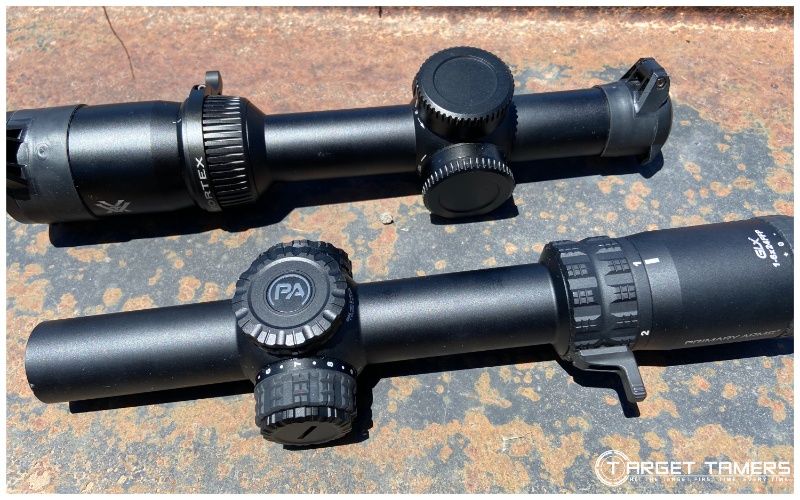
The cost for a Vortex Strike Eagle 1-8x and a Primary Arms GLx 1-6x in the FFP is competitive. The Primary Arms GLx is a mid-tier scope with matching performance and quality. The Strike Eagle is really the entry line to Vortex’s LPV offerings, but it’s an upgrade to the Crossfire and thus fits the mid-tier price point.
I think both are well priced for quality. Considering that cheaper LPVO scopes may be lacking in glass performance, tracking consistency, and durability, the GLx and Strike Eagle fit the expectations of the mid-range market.
Check out our list of the best LPVO scopes from budget to top-tier.
Winner: Tie
Configuration
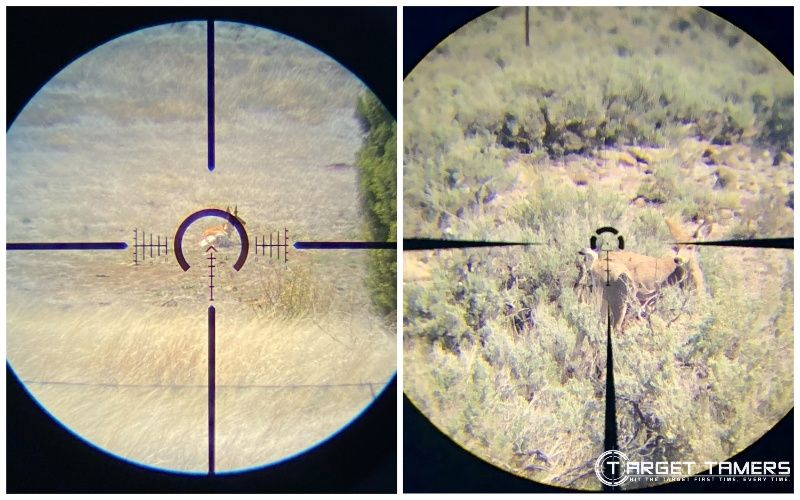
In total, Vortex has a Strike Eagle 1-6x24 configuration, but it has an second focal plane scope reticle. The Primary Arms GLx scope has the reticle in the FFP not SFP (second focal plane scope). At this moment, Vortex only offers a FFP reticle in the 1-8x24 configuration. With that said, the Vortex Optics Strike Eagle offers more magnification than the GLx.
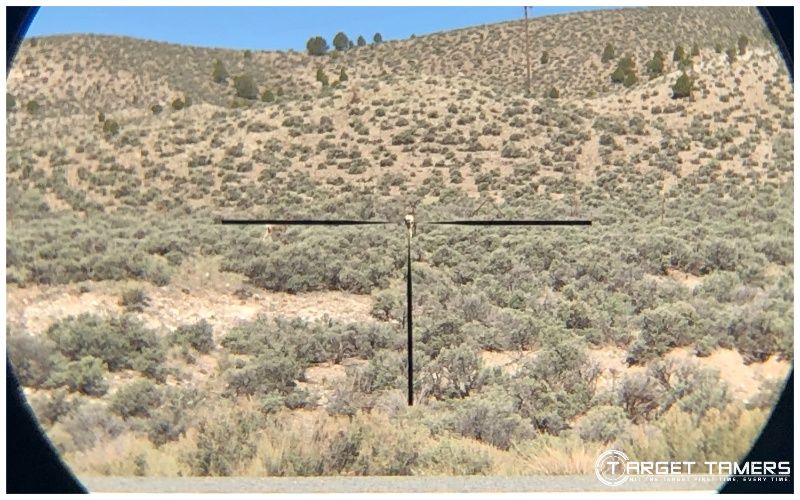
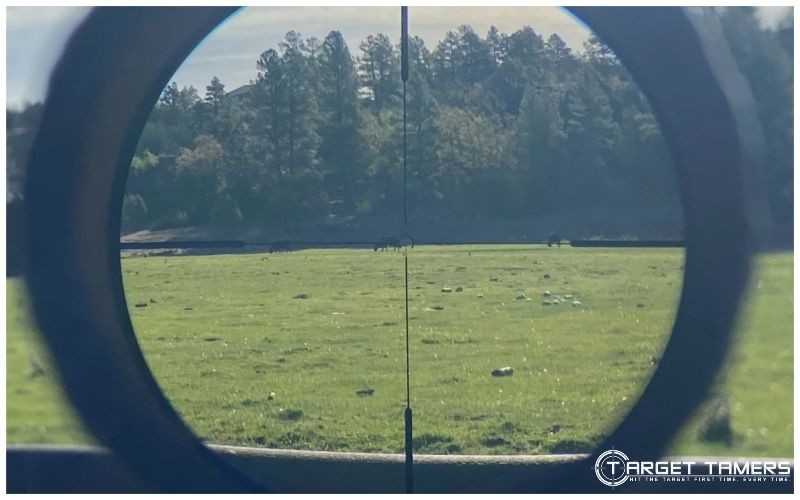
On maximum magnification alone, the Vortex Strike Eagle wins out. However, I’m also looking at focusing, resolution, and reticle size at max power. This is relevant since high magnification (for an LPVO) means nothing if it can't be used. In this comparison, it's about who does it better. Unfortunately, the 8x of the Strike Eagle falls short. The glass performance is better on the Primary Arms GLx.
Additionally, the reticle is larger in the GLx including at 1x than the reticle in the Strike Eagle throughout the entire power range. With all this considered, the Primary Arms GLx FFP LPVO wins configuration.
Winner: Primary Arms GLx 1-6x24 FFP
Optical Quality
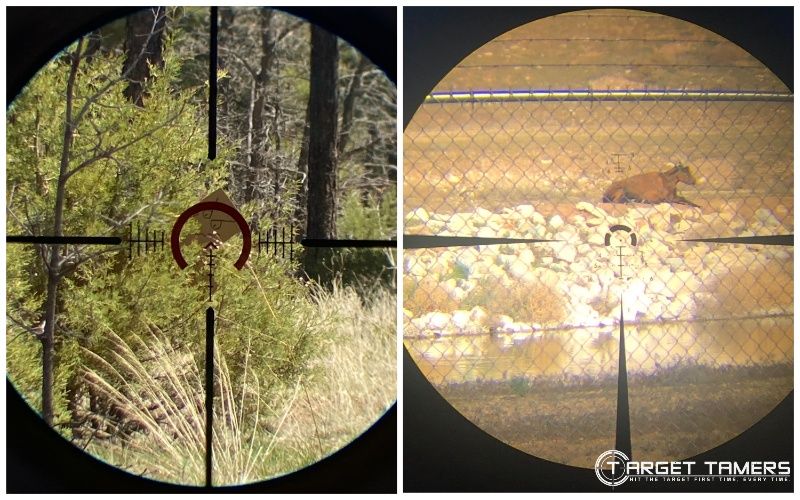
Neither the Vortex Strike Eagle 1-8x or the Primary Arms GLx 1-6x is stated to have ED (extra-low dispersion) elements. However, both performed admirably in overall optical performance with slightly better resolution to the Primary Arms GLx FFP scope.
From field testing, there was very little chromatic aberration (CA) in both scopes. Most of the CA I observed was from digiscoping.
There is some level of spherical aberration in both LPVO scopes especially noticeable when you’re not centered perfectly behind the eyepiece at 1x. This can be a drawback for many that often shoot from awkward positions. This presents some, but minimal, fishbowl-like effects in both scopes.
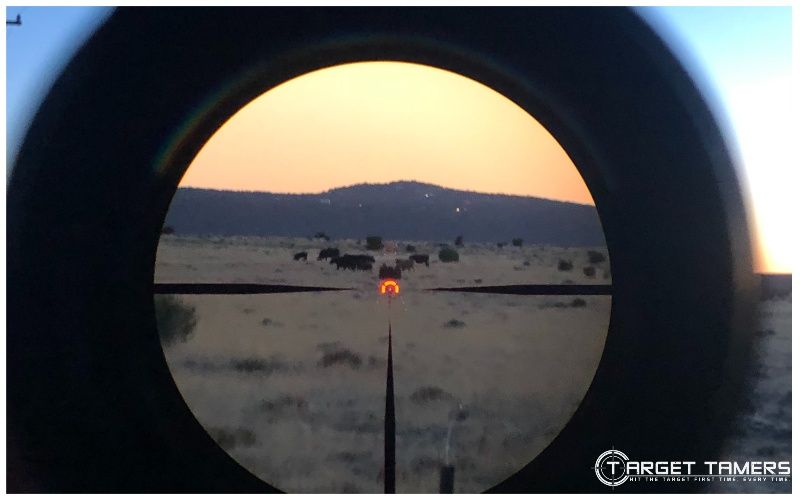
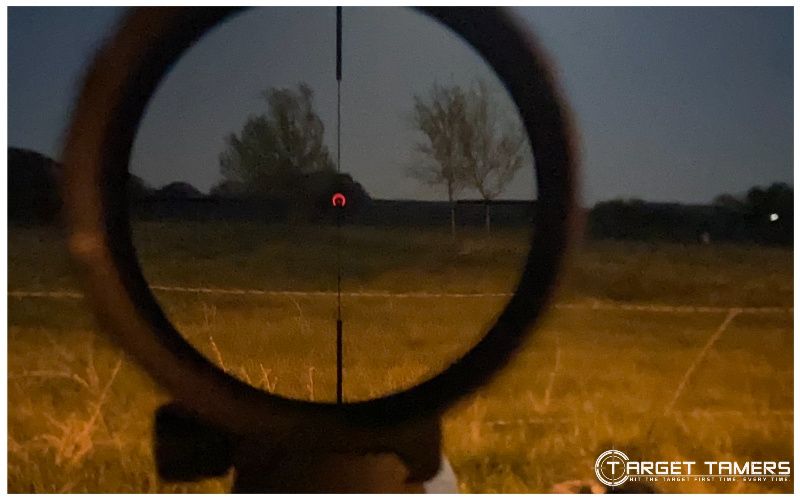
Neither performed exceptionally in low light which is to be expected. The Strike Eagle seemed to have warmer color tones than the GLx, though both suffered from some color drop off at max power.
Though it’s hard to tell through my pics that are subjected to formatting and resolution loss by the time I get them to you, I did prefer the slightly sharper clarity from the Primary Arms GLx scope.
Winner: Primary Arms GLx 1-6x24 FFP
Reticle
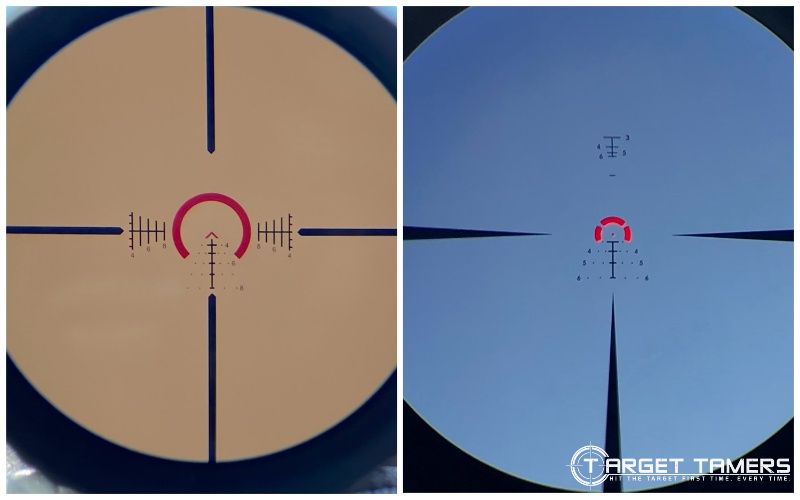
Overall, the reticles in the Primary Arms GLx 1-6x24 FFP and the Vortex Strike Eagle 1-8x24 FFP scopes are similar in that they provide bullet drop, wind holdovers, auto ranging, illumination, and are glass-etched. Both are highly visible even without illumination.
The Primary Arms GLx has the ACSS Raptor M6 reticle with MIL crosshairs. I don’t know the subtension for the ACSS floating center chevron, but it’s very visible and precise. The tip represents your zero which for me was 100 yards.
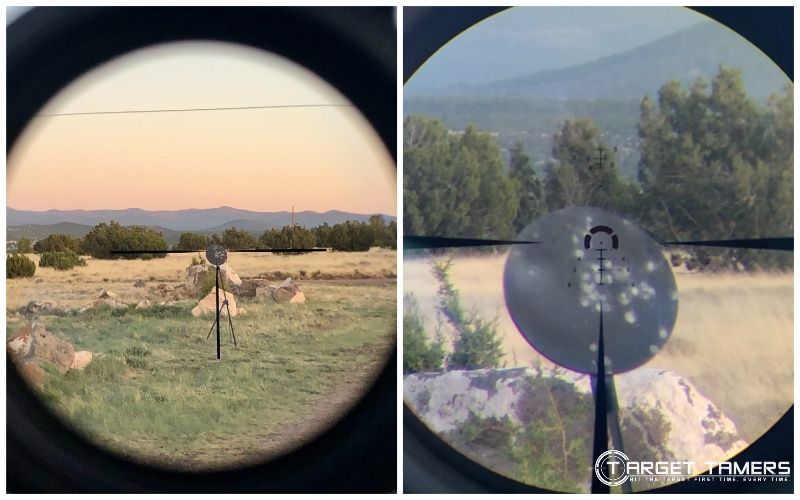
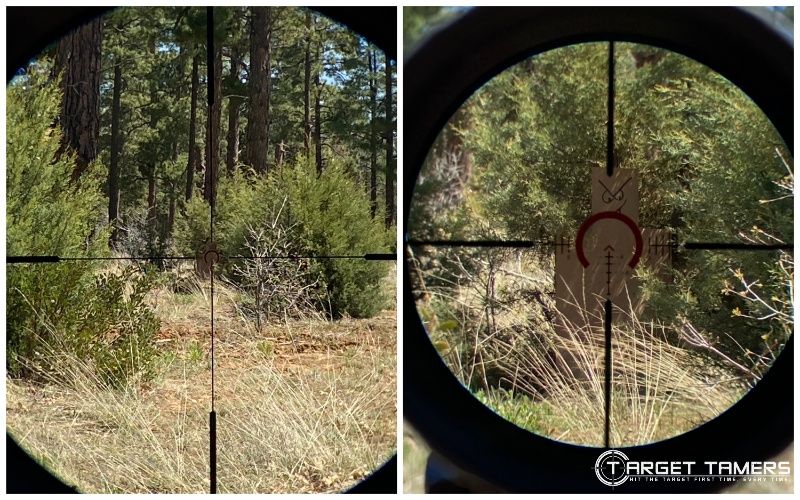
The Vortex Strike Eagle has the EBR-8 reticle in MOA. The floating center dot is 0.75 MOA in size, and with the segmented horseshoe, it acts like a red dot at 1x.
Both provide similar benefits, but it comes down to usability and size. The EBR-8 reticle is small and I’ve never really used the stadiametric ranging reticle though it works just like the auto ranging reticle in the ACSS Raptor M6 reticle.
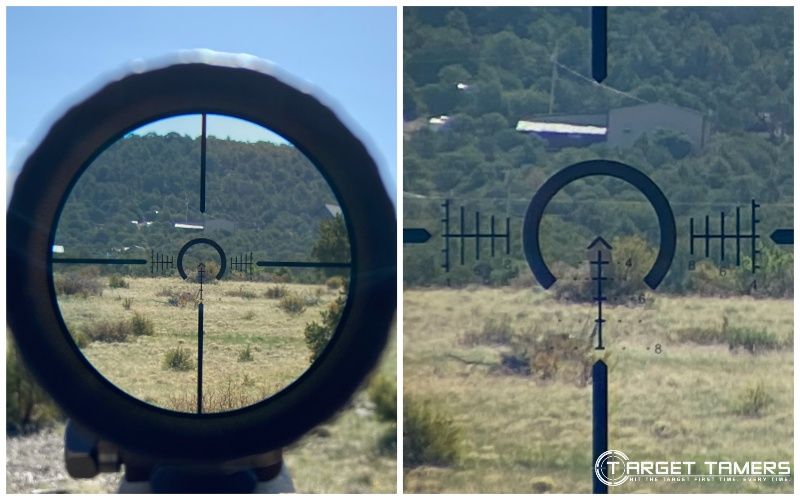
Why I prefer the ACSS for auto ranging center mass targets is because the reticle is a lot bolder, bigger, and visible. It’s easier to quickly use and get the right holdover since it’s all in the main reticle versus the EBR-8.
Winner: Primary Arms GLx 1-6x24 FFP
FFP Reticles
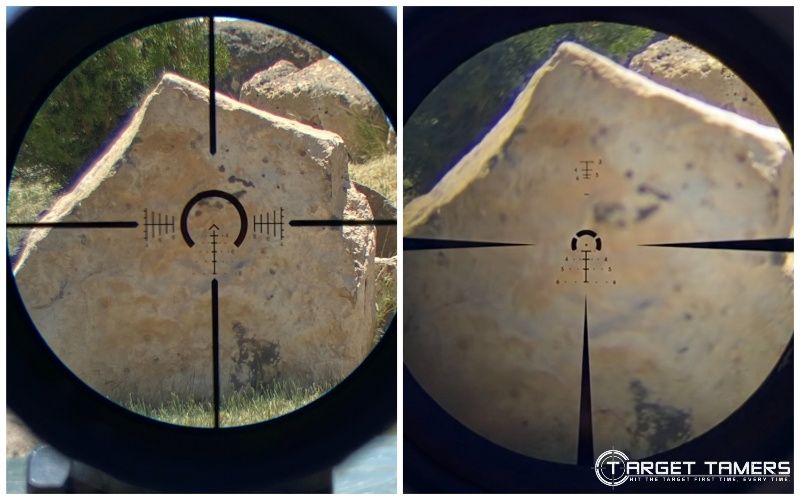
Both reticles in the Primary Arms GLx and the Vortex Strike Eagle are in the first/front focal plane. They get larger as magnification is increased while subtension remains the same throughout the power range. Though they are both equal in concept and design, they are not equal in performance.
The reticle in the Vortex Strike Eagle at 1x is extremely small. It is really only good for use with the illumination on as it behaves more like a red dot sight. As this is largely the point of a FFP LPVO at 1x, I don’t hold it against it.
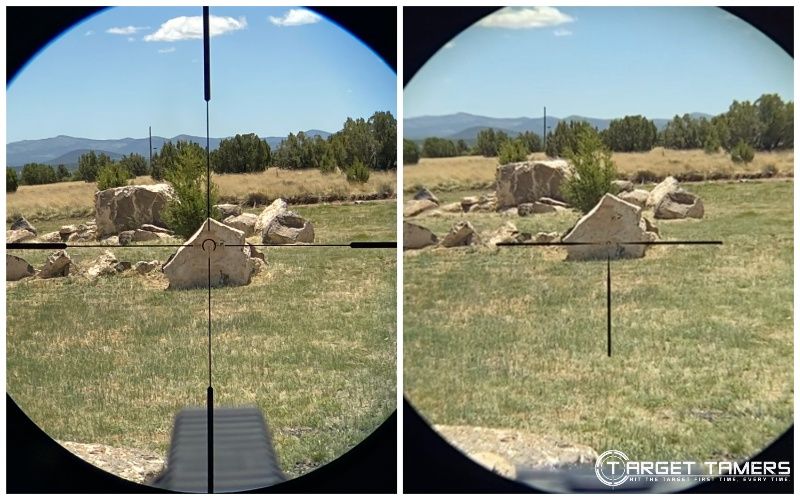
However, I’m really only seeing the horseshoe at 1x with the Strike Eagle. In this manner, the horseshoe is my aiming point rather than the center dot.
With the GLx, the reticle is larger even at 1x, and I’m able to get advanced combined sighting system on both the horseshoe and the floating chevron helping to improve accuracy.
Really at 1x and at close quarters, the horseshoe is what draws the eye and aids in rapid target acquisition. But because the ACSS is bigger even at 1x, I prefer the FFP reticle in the GLx scope.
Winner: Primary Arms GLx 1-6x24 FFP
Eye Relief
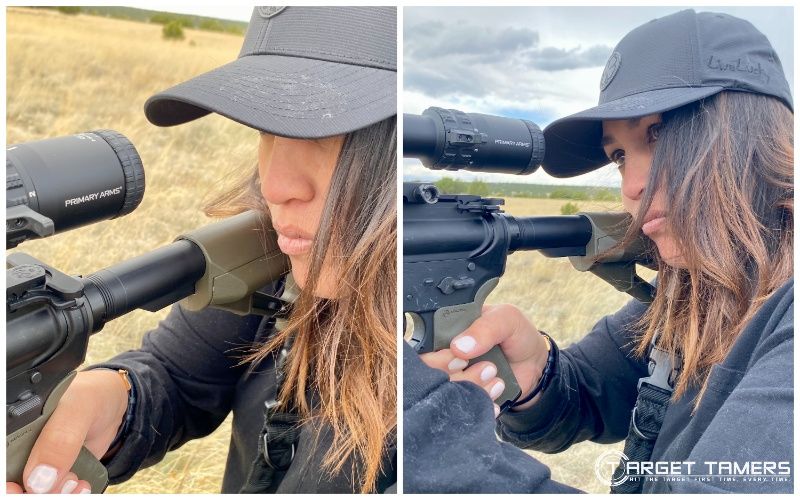
LPVO scopes are not known for their forgiving eye relief unlike red dot sights. Though the eyebox gets tight at max magnification, both the Vortex Strike Eagle and the Primary Arms GLx have great eye relief for the AR-15 and most bolt action rifles.
The Strike Eagle specs say that eye relief is 3.9” long, and I found this spec to be accurate enough at maximum 8x power. At 1x, it was more like 5”.
The Primary Arms GLx specs says that eye relief is 3.5-3.3”. I found this to be far from true. I found it very forgiving at 1x with around 5” of eye relief. At max 6x power, the eye relief is still long at about 4-4.5”.
Though my measuring process is crude, and I found the eyebox a little more friendly with the GLx, I found both to have longer eye relief than the listed specs. I haven’t had an issue with either in this regard.
Winner: Tie
Field of View (FOV)
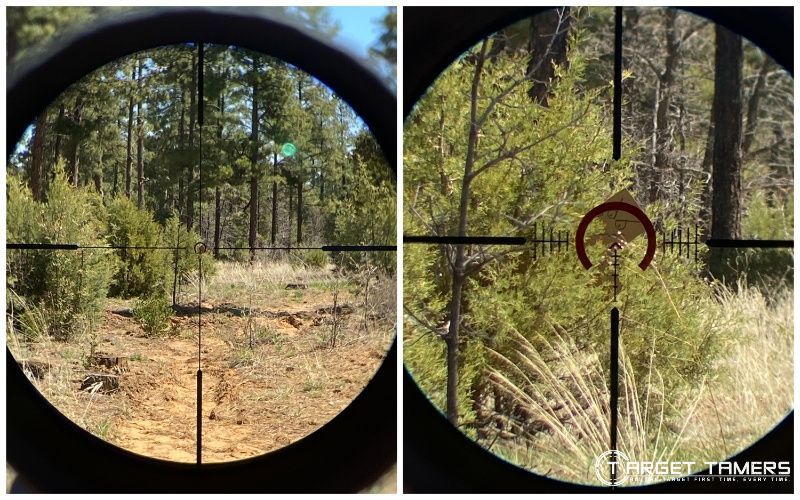
Interestingly, though the Primary Arms GLx 1-6x FFP scope has less maximum power, the Vortex Strike Eagle 1-8x FFP scope has a wider field of view. The Strike Eagle has a FOV of 113.6-14.1 ft at 100 yards while the GLx has a FOV of 104.7-13.3 ft at 100 yards.
I’ve looked through both of these scopes to get a general idea of FOV comparisons, and the Strike Eagle indeed has wider breadth than the primary arms GLx scope.
Winner: Vortex Strike Eagle 1-8x24 FFP
Parallax
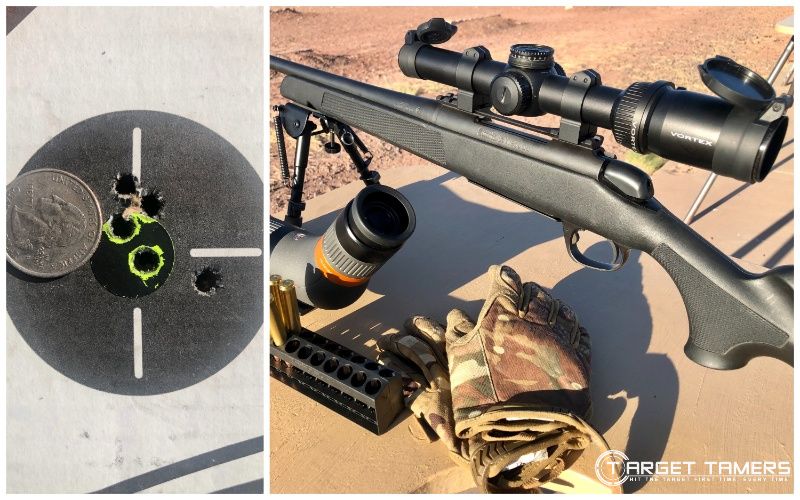
The Vortex Strike Eagle 1-8x and the Primary Arms GLx 1-6x scopes have fixed parallax. Neither scope offers a parallax correction feature in the form of an AO or side focus. Vortex states that the Strike Eagle has fixed parallax at 125 yards.
I don’t know what the actual fixed parallax setting is for the Primary Arms GLx scope, but I’m assuming it’s about 100 yards. I haven’t had any issues with it and I’ve taken it out to 300 yards and nothing was amiss.
But because Vortex states the fixed parallax setting, and it is a spec people want to know, Vortex gets it.
Winner: Vortex Strike Eagle 1-8x24 FFP
Adjustment Value & Turrets
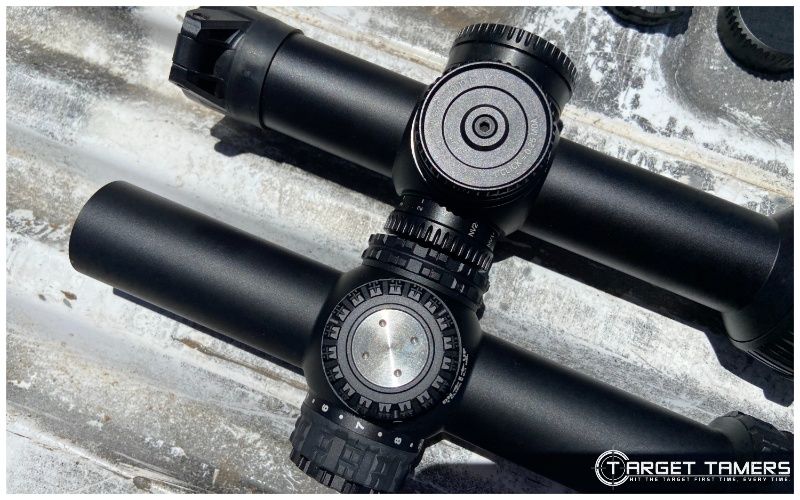
In general, most people have a preference for a riflescope’s measuring system. Some prefer MILS and others prefer MOA. The Primary Arms GLx with the ACSS Raptor M6 reticle offers a MIL/MIL system while the Vortex Strike Eagle with the EBR-8 reticle offers an MOA/MOA system.
The Vortex Strike Eagle has adjustment values in 0.25 MOA clicks with elevation and windage travel of 145 MOA. Each revolution offers 25 MOA.
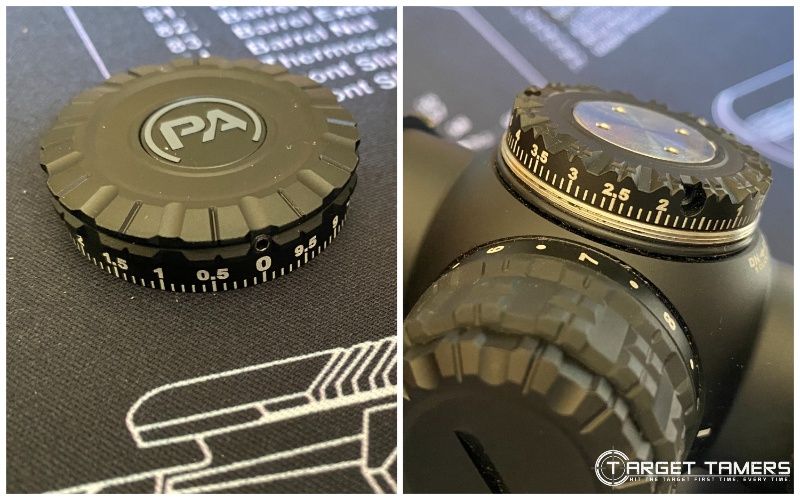
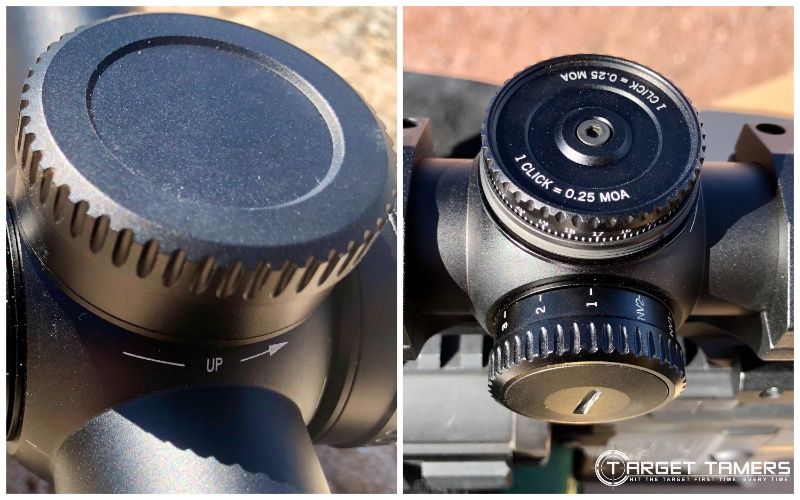
The Primary Arms GLx has adjustment values in 0.1 MIL clicks with elevation and windage travel of 200 MOA each. This works out to be something like 58 MILs (approximately). Both the standard and exposed turret have 10 MILs each revolution.
As far as I know, Primary Arms does not offer an identical scope in the MOA alternative. This goes for Vortex as well as they do not have a MIL alternative.
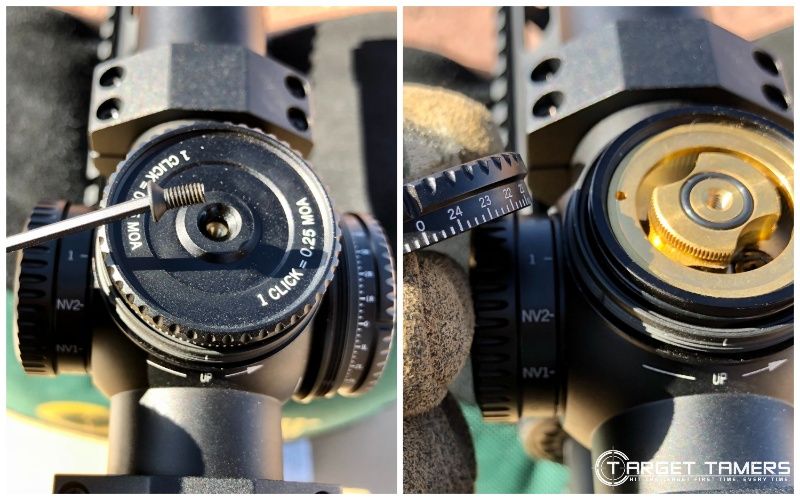
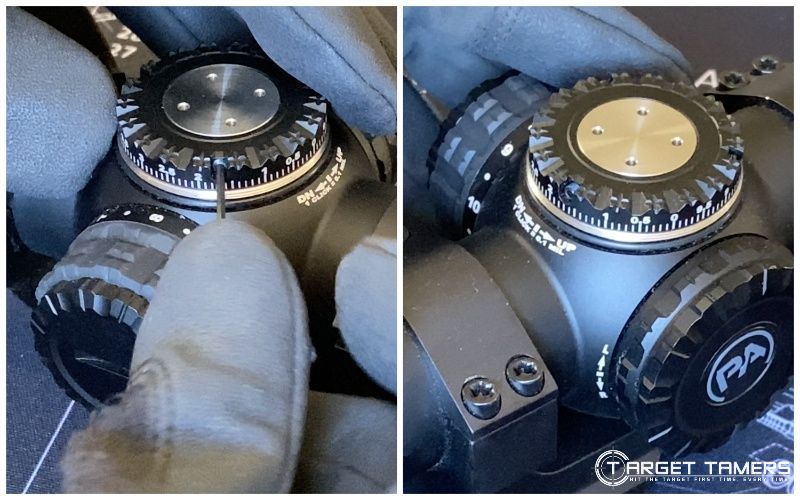
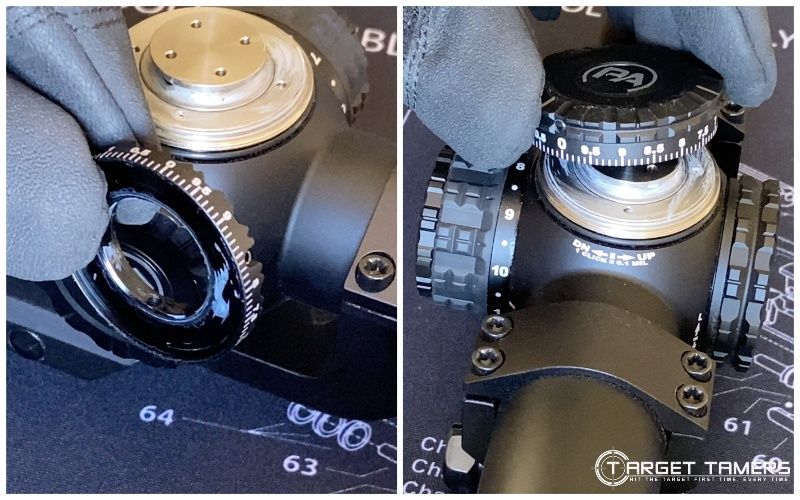
I really like that the GLx comes with an exposed turret in the box as an extra accessory for those who want it.
Less than a decade ago, matching MIL/MIL systems and FFP reticles were difficult to find at an affordable price point (Schmidt & Bender, Hensoldt, etc – not affordable!).
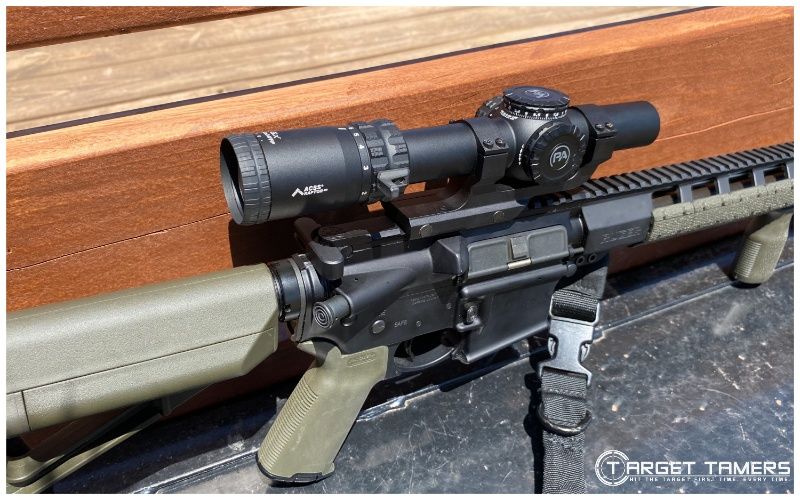
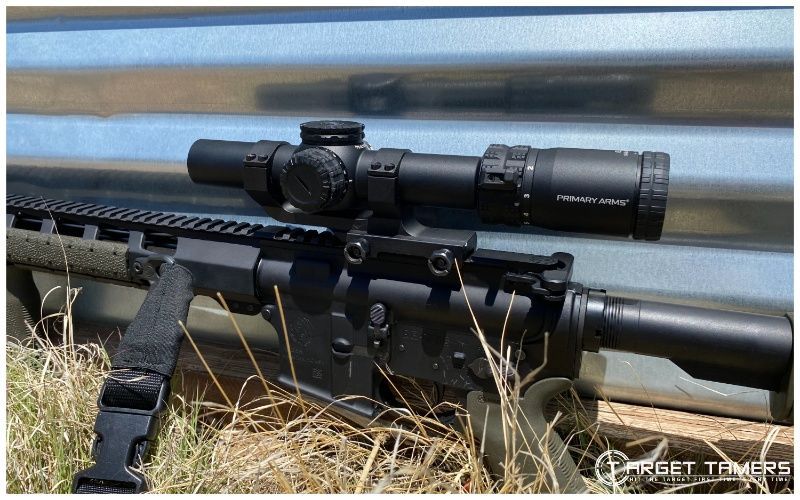
Mix and matching capped and exposed turrets is usually an extra cost after the fact as a customized purchase. The fact that this extra turret just comes in the box offers fantastic value. Personally, I zeroed with the standard turret, and I keep it on the scope.
As to which system is better, neither inherently bests the other. It’s a personal preference whether one wants an MOA system or a MIL system.
Scope over our guide for an MOA VS MIL comparison.
Winner: Tie
Illumination & Battery Type
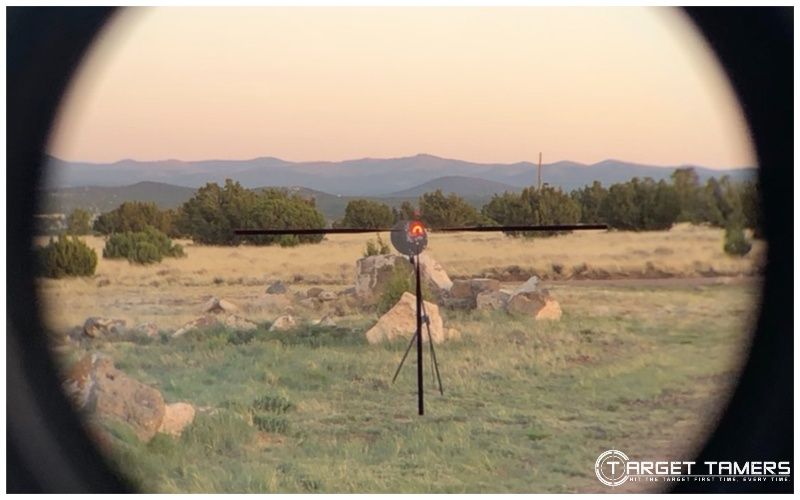
In general, illumination is a standard feature for an LPV scope. The Vortex Strike Eagle and the Primary Arms GLx LPVO scopes have illumination powered by a CR2032 battery that is housed in the third turret on the left side of the body.
The GLx has 10 brightness settings with intermittent off positions and rotates both forwards and backwards past max 10 and the dimmest 1 setting. So, you can go from 1 to the brightest 10 setting and vice versa easily. The intermittent stops are extremely convenient.
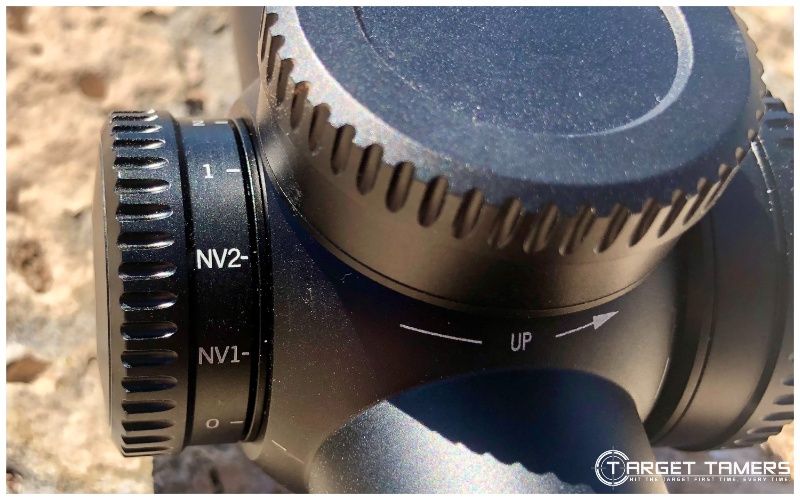
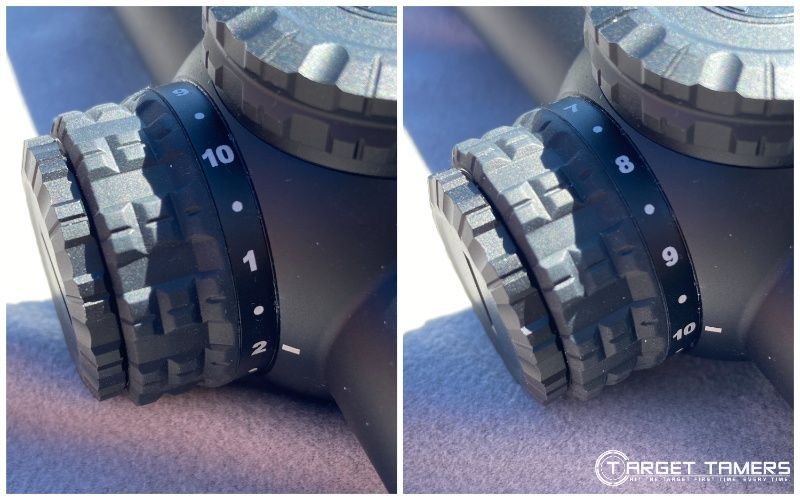
The Strike Eagle has 9 daylight settings and 2 separate night vision compatible settings. There is a ‘0’ setting to turn off the illumination as there are no intermittent off positions. Though you can rig an ‘off’ setting between the illumination levels, you must be precise about it. The turret can easily be knocked out of position to reactivate the illumination.
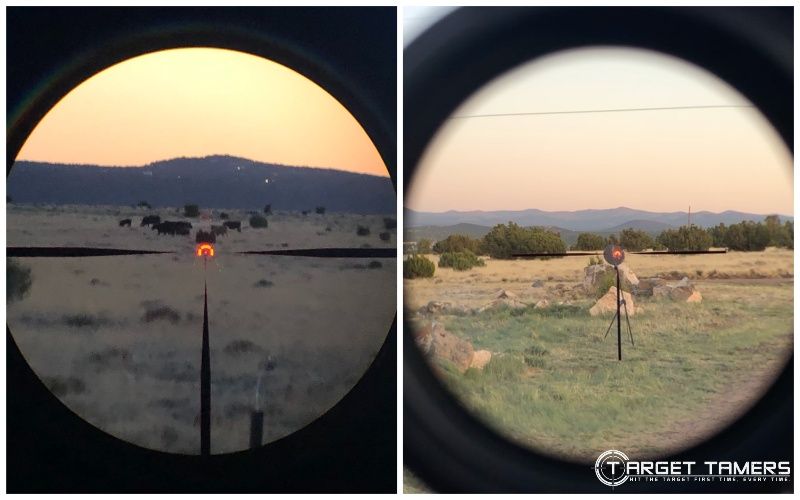
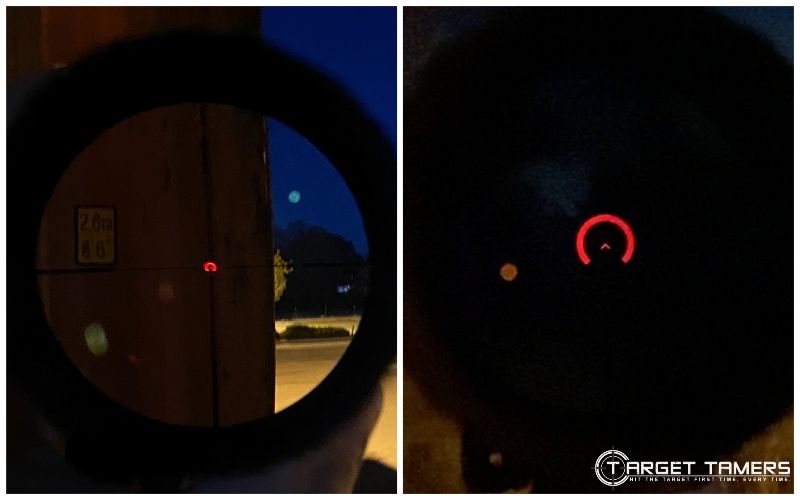
Both have partial illumination meaning that only the center aiming point and the horseshoes should be illuminated. The Strike Eagle has far more illumination bleeding than the GLx scope but is brighter.
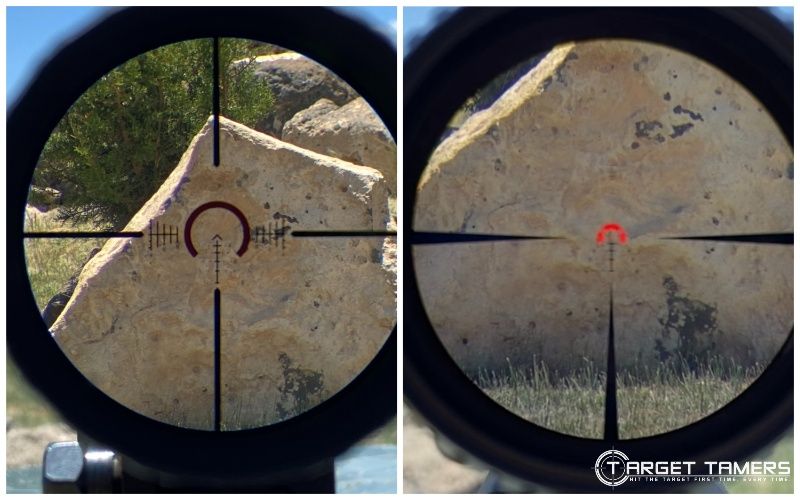
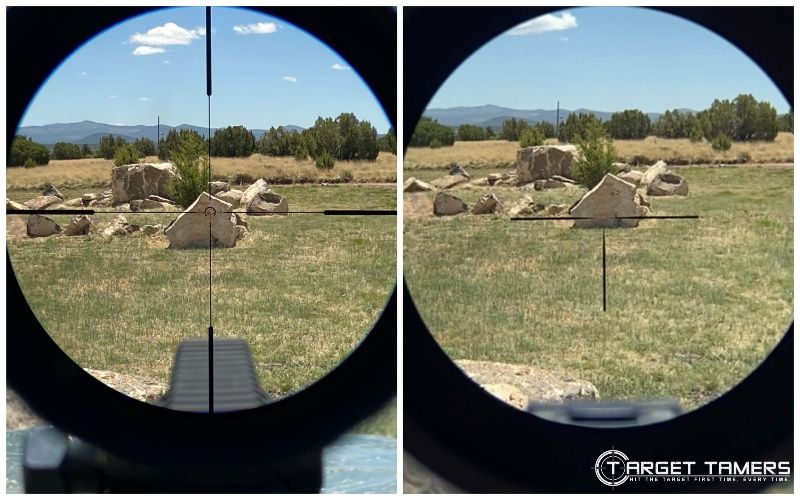
The GLx has a bigger reticle, so it’s easier to see without illumination. Though I had a hard time seeing the illumination in bright daylight, it was ideal for lowlight conditions – when illumination is actually needed.
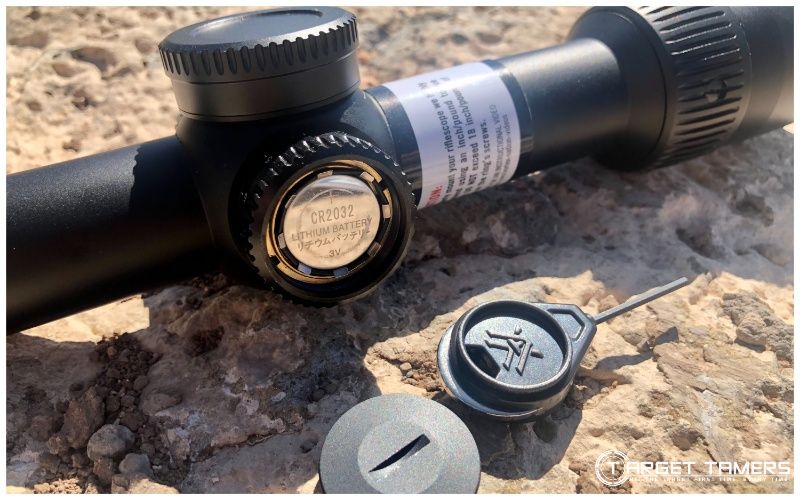
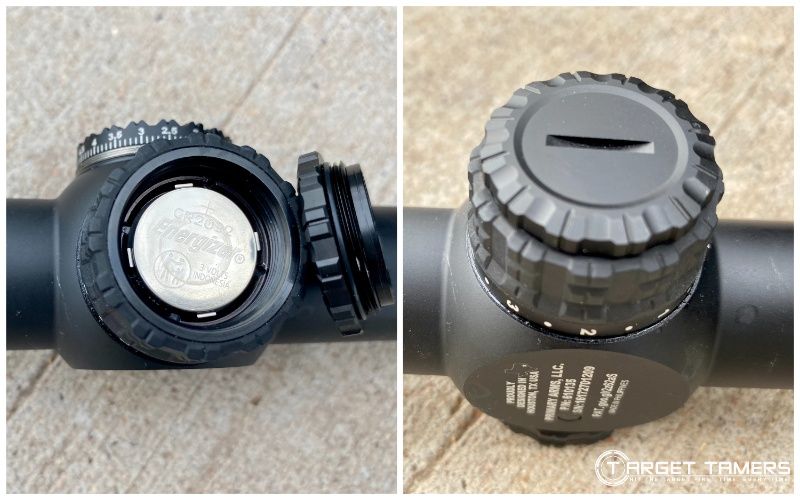
So, as far as brightness goes, the Strike Eagle has it. As far as which illumination knob is easier and more convenient to use, the GLx has it. Battery type is a moot point because they use identical batteries to power the illumination.
However, since illumination is supposed to help with reticle visibility in hard to see conditions, day or night, the Vortex reigns.
Winner: Vortex Strike Eagle 1-8x24 FFP
Size & Weight
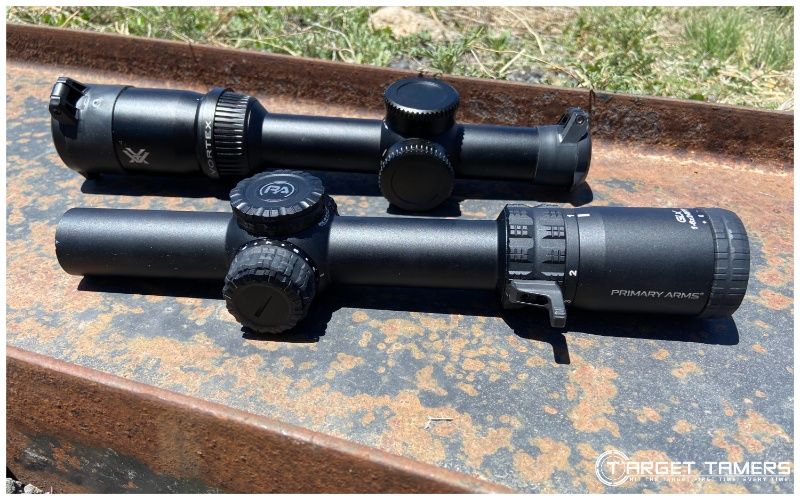
Overall, LPVO scopes are heavy even with their low magnification and small objective lenses. They range from 16-25 oz in weight and are generally around 9-11” long. They typically have 30mm tubes. The most compact and lightest LPVO between the Primary Arms GLx and the Vortex Strike Eagle is the GLx.
The GLx comes in at 10.25” long (according to the specs) and weighs 21.3 oz. The SE comes in at 10.4” long and weighs 24 oz. Honestly, I feel no difference in weight between either in the hand.
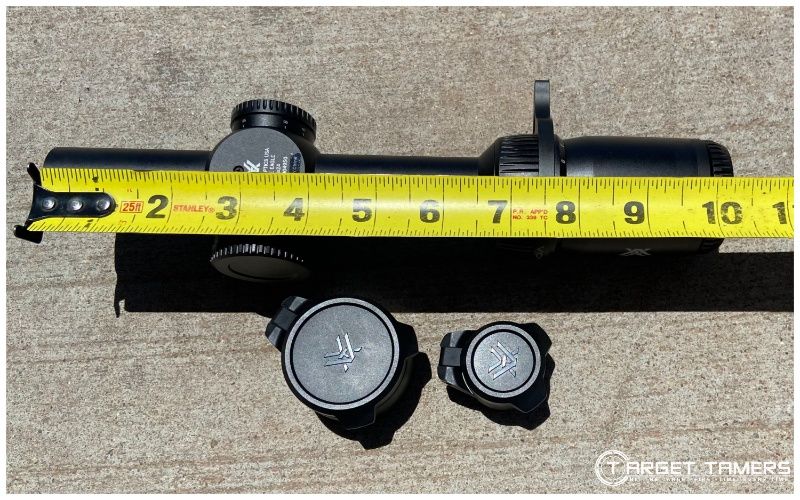
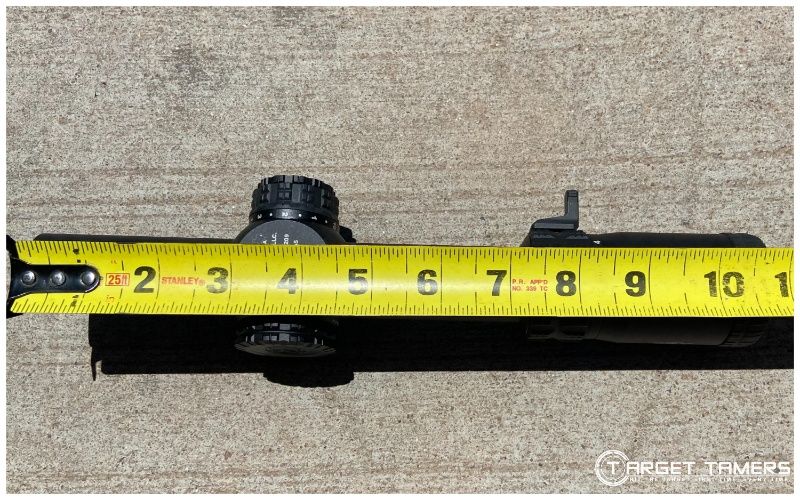
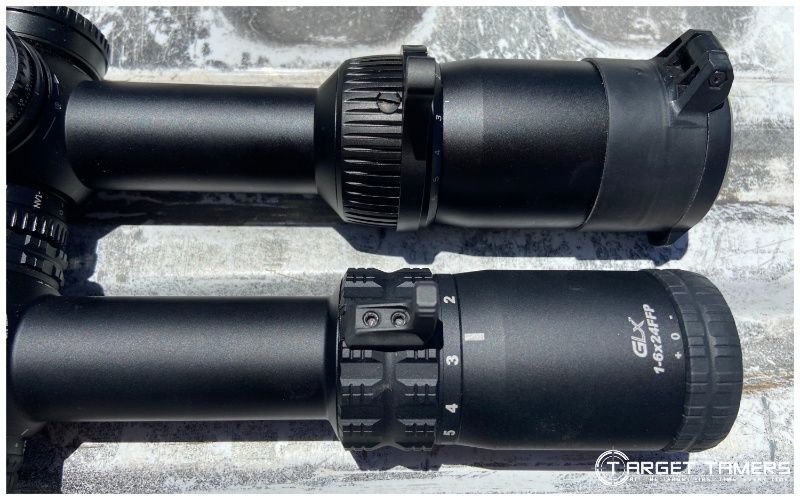
Now, when it comes to confirming length, it’s a different story.
The GLx comes in slightly longer than the Strike Eagle at almost 10.75” while the Strike Eagle comes in at 10.25”. Though the GLx is longer, it’s more compact in size. The Strike Eagle has larger windage and elevation turrets and a huge ocular bell.
The GLx has lower profile turrets and a smaller ocular bell. Side by side, I prefer the GLx.
Winner: Primary Arms GLx 1-6x24 FFP
Durability
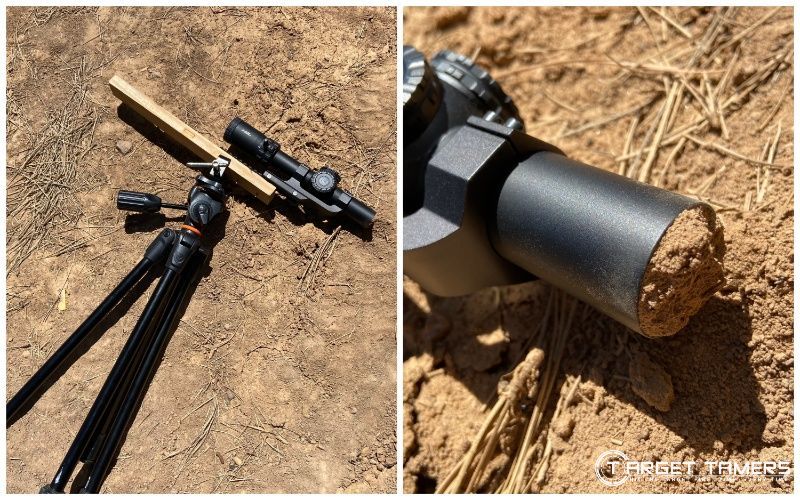
Quality is felt in the hand between both the Primary Arms GLx 1-6x FFP scope and the Vortex Strike Eagle 1-8x FFP scope. Both are waterproof and fogproof. They are both well-made with the Strike Eagle manufactured in China and the GLx made in the Philippines.
I’ve water tested both, but I think it’s fair to say that the Strike Eagle had it worse than the GLx. While I only simulated a downpour on the GLx, the Strike Eagle was completely submerged for 30 minutes.
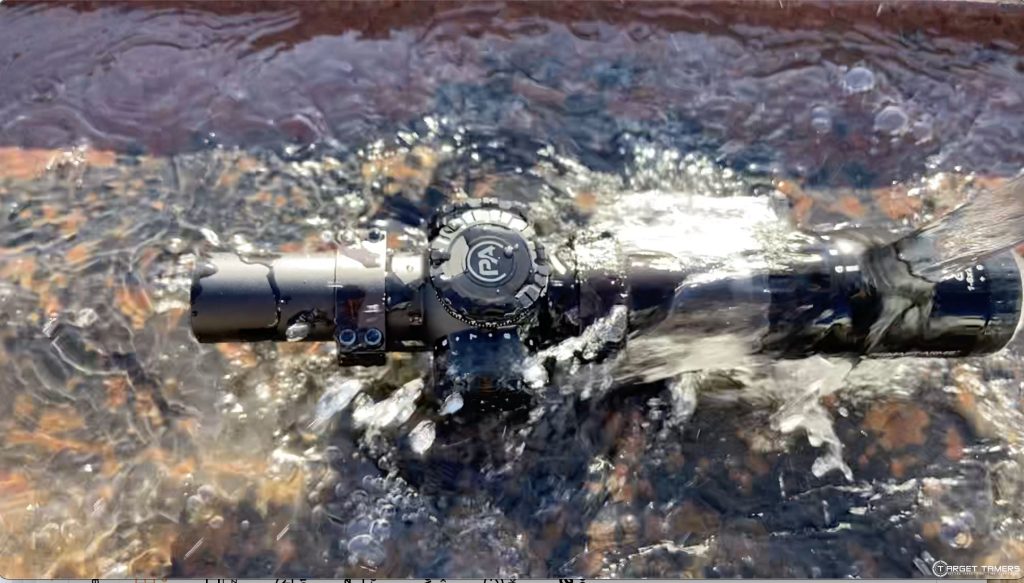
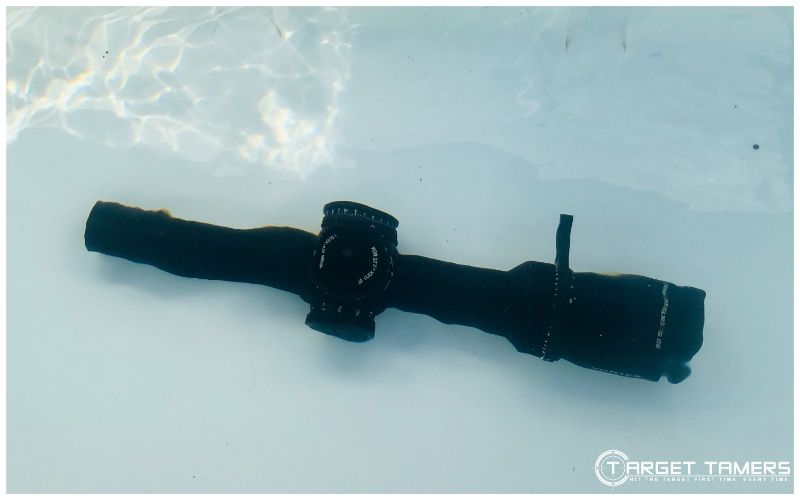
I’m not intentionally rough with optics, but they do go through a hard time between constant mounting and unmounting, exposure to dust and dirt (it’s mountain desert country – what can I say), and I often get caught out in the rain whenever it’s range day. Most recently, they’ve performed without issue under scorching suns.
The turret system in the GLx is stainless steel on stainless steel for precision adjustments while I’m pretty sure that the Strike Eagle has brass on stainless steel. Though this is a hot topic among enthusiasts, you can be the judge of what you prefer.
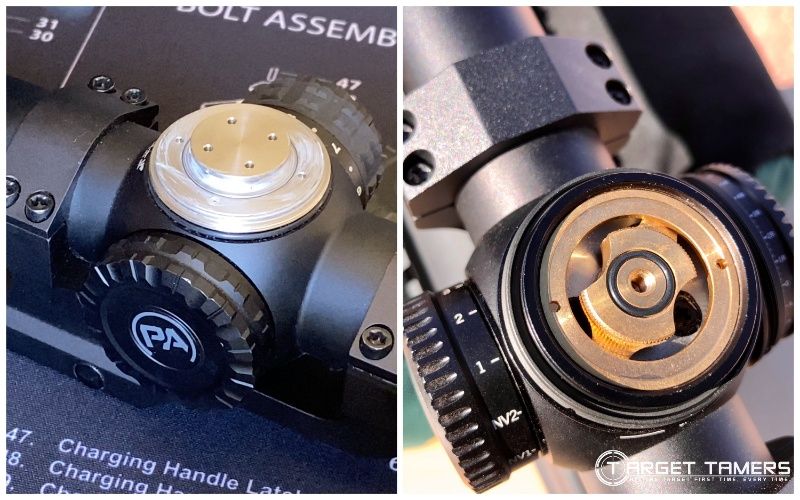
I’ve had no issues with zero retention between either. The GLx has been used in direct Arizona sunlight from sunup through to late afternoon. The Strike Eagle has been mounted to a muzzleloader and punished. Both have suffered under my unintentional abuse from drops and knocks. Neither show scratches or dings in the finish.
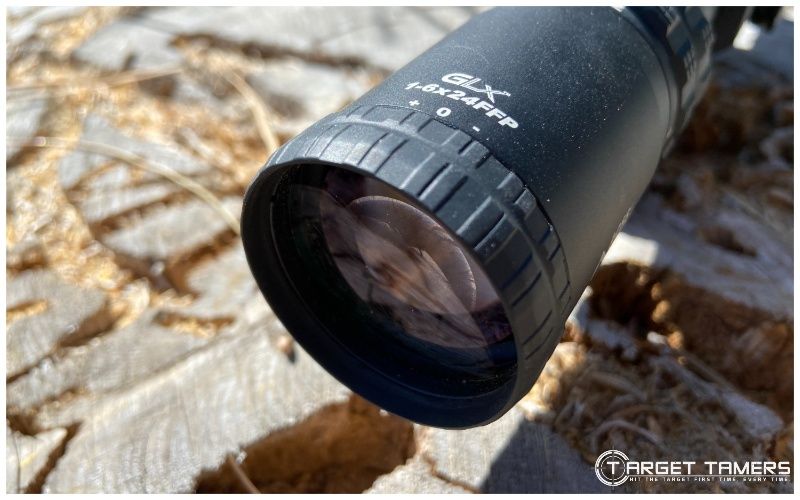
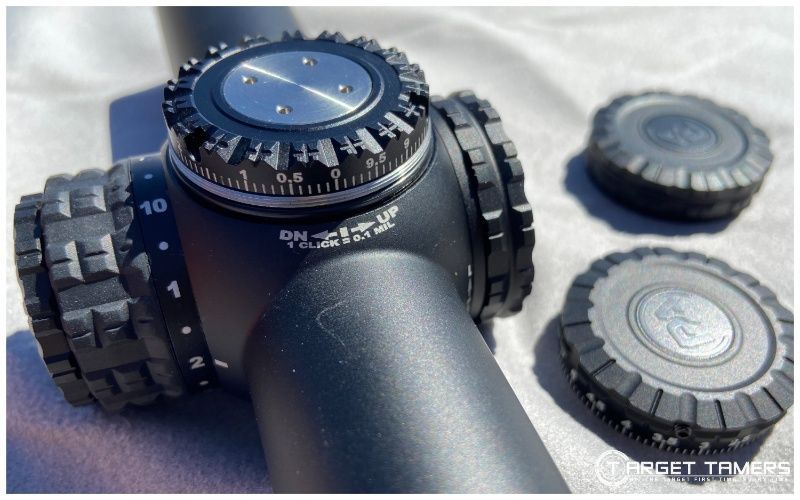
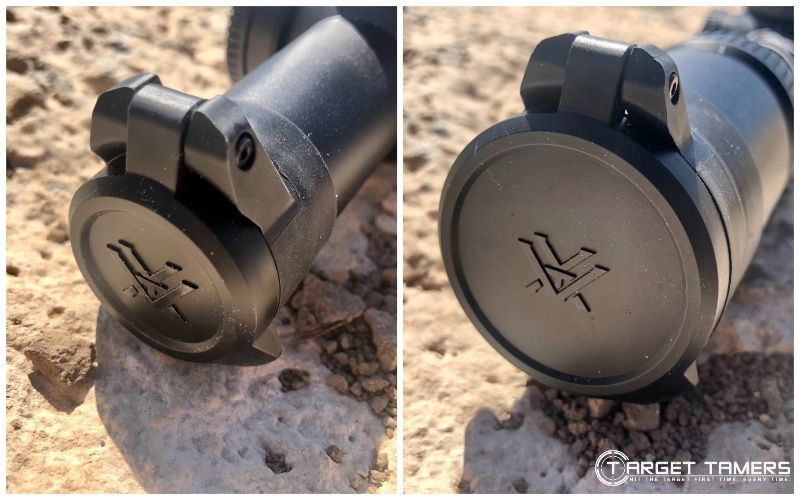
To narrow down the margins, the illumination knob on the Strike Eagle has a little play and less resistance than the tighter knob on the GLx. I really like the rubber coating on the diopter and illumination knob on the GLx. The rubbered diopter makes it easier to grab and use but is of equal resistance in movement to the Strike Eagle diopter. The knurling on the turrets is sharper but grippier on the GLx than the Strike Eagle. However, the Strike Eagle comes with flip-up caps for lens protection while the GLx does not.
Though I’m partial to the GLx in durability, it would be fair to judge this as a tie.
Winner: Tie
Included Accessories
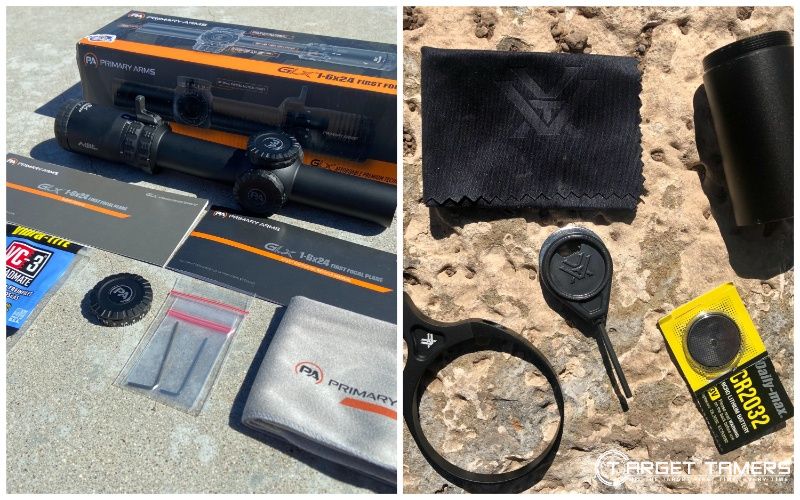
On average, included accessories are usually junk. This ranges from the lens cloth to the tools and any sort of lens protection that is included. However, the Vortex Strike Eagle and the Primary Arms GLx scopes seem to be the exception to the rule.
The Primary Arms GLx 1-6x FFP scope comes with an exceptional microfiber cloth that I will be keeping and using going forward. It’s oversized and is practical to work with.
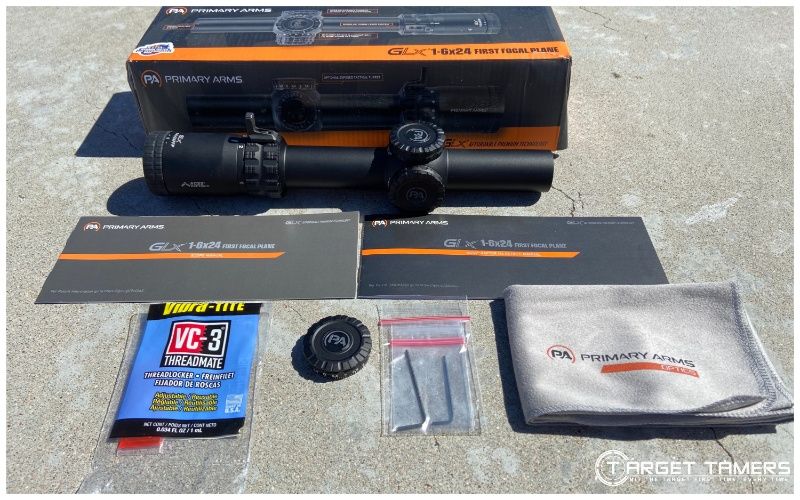
Not all LPV scopes come with an included throw lever, and Primary Arms included a quality, metal power fin. It’s configurable meaning that it has a dovetail base that allows it to be removed from the magnification ring and replaced with a different (compatible) one.
The other accessory of note is the exposed tactical turret. It's fully contained – so it’s waterproof by itself.
A small pouch of threadlocker is included but I’m positive that it’s intended for the mounting system, of which, a cantilever mount is not included and must be purchased separately. The accessories that come with the GLx may be minimal, but they’re extraordinary compared to the standard expectations.
Accessories of note included with the Vortex Strike Eagle consist of a sunshade, flip-up caps, and band throw lever. Yes, it comes with a tool, battery, and lens cloth just like the GLx, but the cloth pales in comparison to the one that comes with the GLx.
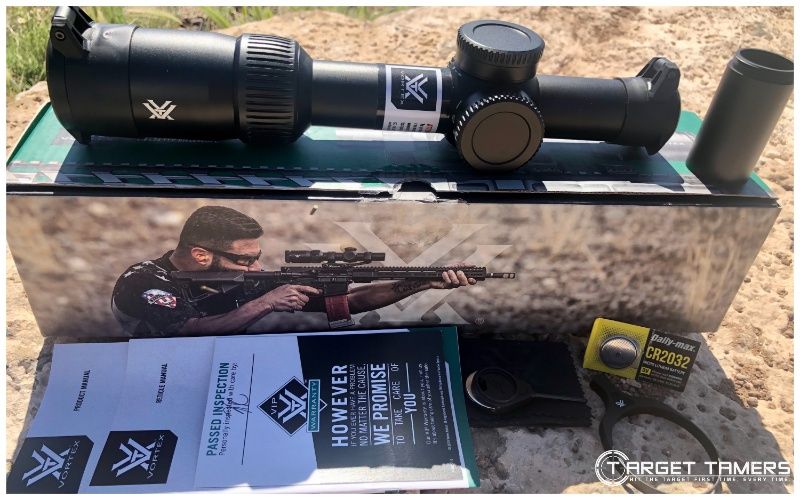
The sunshade is awesome, and I always like to put them on the scope if it’s included. The band throw lever is of good quality. I haven’t had any tension or loosening issues since I installed mine. You can always switch it out for a different one but there’s really no point since they’re all similar and can be manufacturer specific.
As far as comfort goes between both power levers, the Vortex one is more ergonomic against the thumb and fingers as it has height on its side.
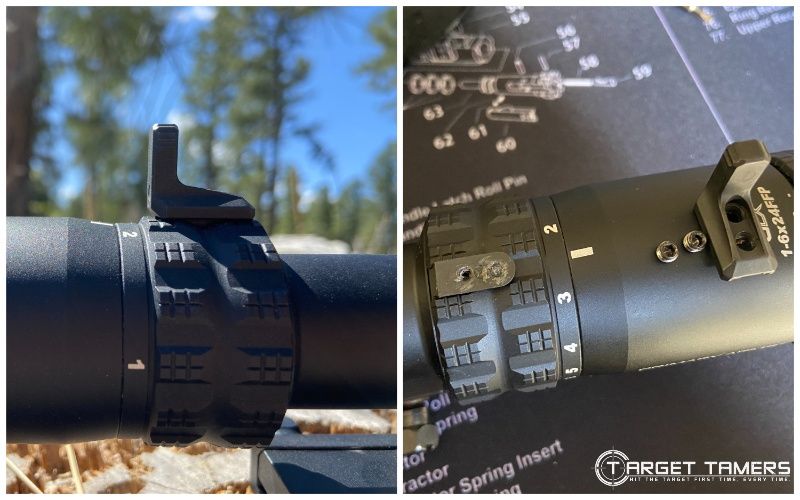
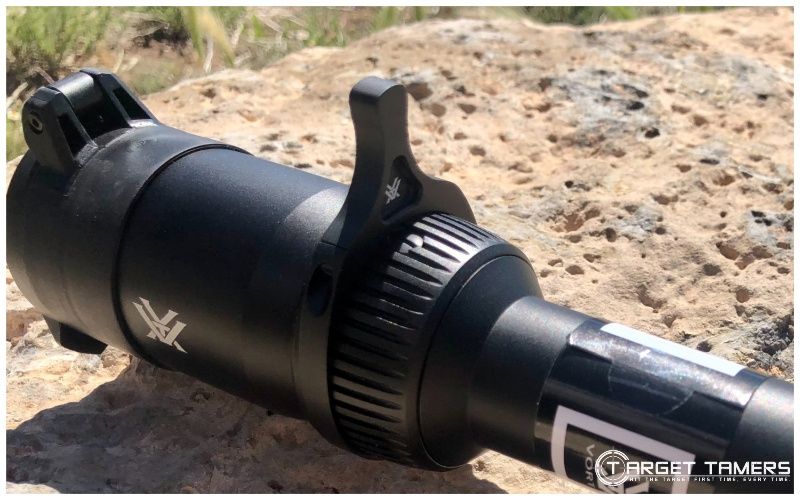
I really appreciate lens protection, so it's a plus that the SE comes with flip-up caps. The rear cap does inhibit use of the diopter, but it's a one-time adjustment anyways. My only problem with them is that they pop off the scope rather easily.
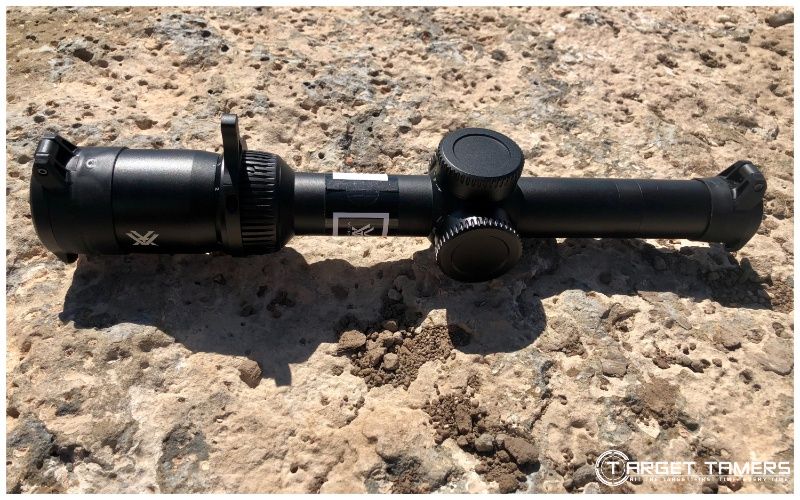
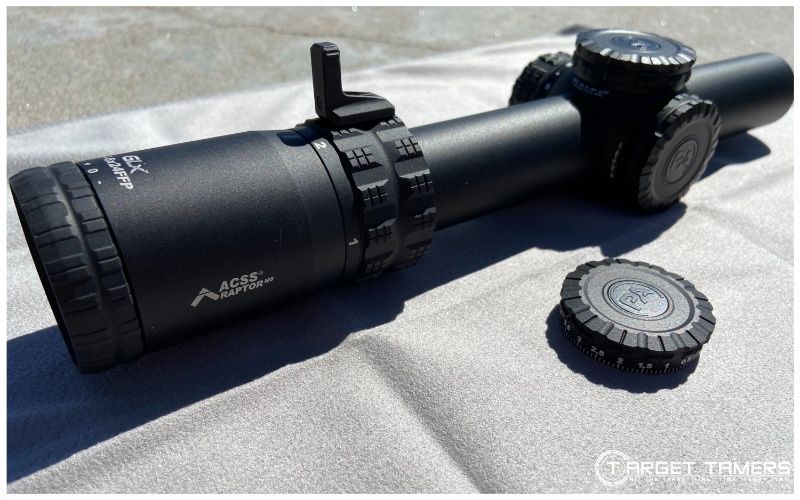
Overall, I think the accessories included with the GLx scope offer more durability and versatile use. The sunshade, flip-up caps, and band lever with the Strike Eagle are great, but I don’t think they compare in value to the Primary Arms accessories.
Winner: Primary Arms GLx 1-6x24 FFP
Special Features
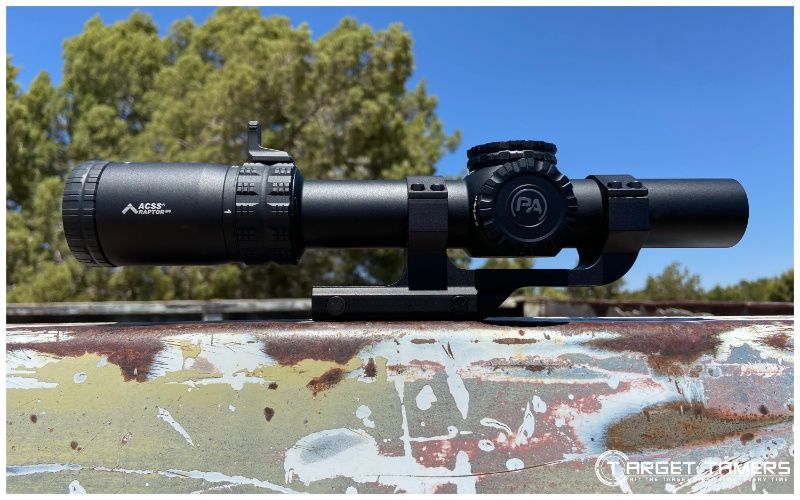
The Primary Arms GLx 1-6x FFP scope has notable features that the Vortex Strike Eagle 1-8x FFP scope cannot compete with. The GLx is complete with AutoLive for motion sensor benefits and the included exposed tactical MIL turret can be considered a special feature as it’s an included accessory.
The AutoLive feature is a motion sensor technology that is not unlike what is seen in red dot sights. Well-known comparisons include Holosun’s Shake Awake and Sig Sauer’s MOTAC.
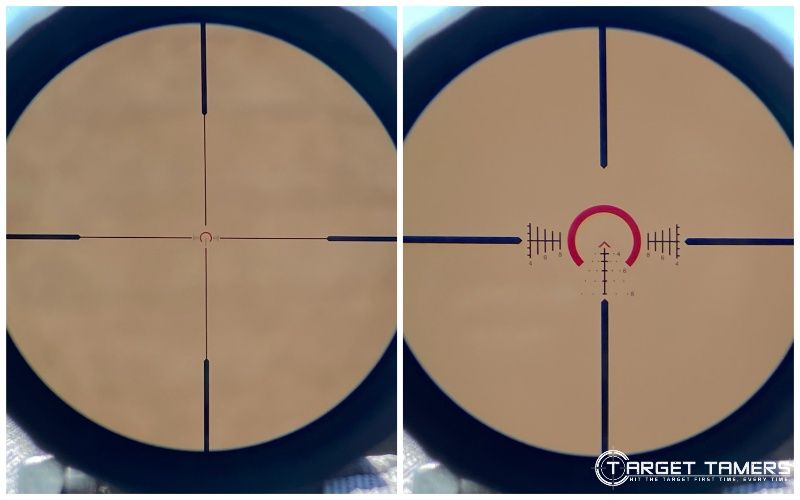
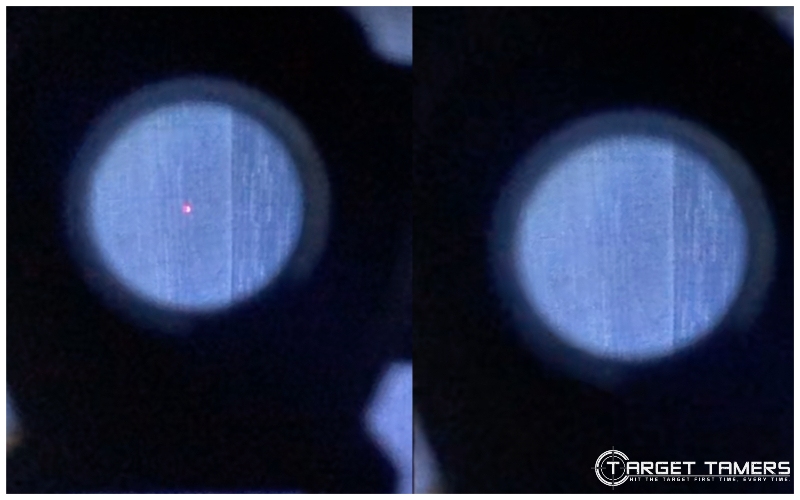

The GLx scope with AutoLive conserves battery life, and I’ve estimated that it has about 600 hours of operation on a single CR2032 battery. I did have to change the battery after around a month of use.
The AutoLive puts the illumination into standby after three minutes of non-motion. Though this is a great feature, it’s really easy to take a second to turn the illumination one notch in either direction – to an intermittent off setting.
Winner: Primary Arms GLx 1-6x24 FFP
Who is the Primary Arms GLx 1-6x24 FFP Best Suited To?

The Primary Arms GLx 1-6x FFP LPVO earns the right to be placed in the mid-tier category of quality. It’s a solid scope with quality moving parts, exceptional accessories, and optical performance that is great for an LPV scope at its price point.
I personally prefer the Primary Arms GLx scope for its slightly better optical performance, larger and more visible reticle, and I like the fact that it comes with the optional turret.
I can recommend it for hunting, range use, and tactical applications like law enforcement. It’s mid-grade and offers solid and consistent performance that I think professionals would be pleased with. The Primary Arms GLx LPVO is a worthy upgrade for someone looking for the configurable adjustment features of the GLx and a MIL based scope.
Regarding the warranty, it’s lifetime coverage. Primary Arms even states that they’ll honor coverage on scopes that have malfunctioned due to normal wear and tear.
Who is the Vortex Strike Eagle 1-8x24 FFP Best Suited To?
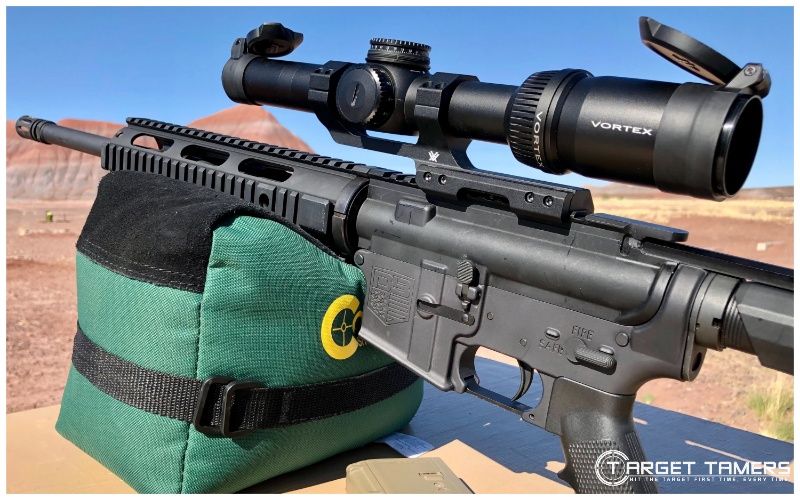
The Vortex Strike Eagle LPVO is a great option for those accustomed to and desire an MOA/MOA scope. It’s simple, easy to use, and has everything it needs to function as a mid-range scope. The reticle could be bigger at 1x, but the illumination works well, it has a wide FOV, and it’s tough.
I like the Strike Eagle and think that it’s a good LPVO. It has a tidy reticle, but I do prefer it at the higher powers to improve reticle visibility.
Though I can recommend it for multiple applications from hunting to range use, it’s on the entry-level end for tactical uses like law enforcement. This would be a good option for a new shooter and those who prefer the MOA system.
One of the best things about it is the VIP warranty. Vortex has proven itself in the customer service arena to where people want a Vortex optic based solely off the trust and reputation that they will honor it.
FAQ's
Both the Vortex Strike Eagle 1-8x and the Primary Arms GLx 1-6x would be excellent for various types of hunting. Though the Strike Eagle has more magnification range, there is noticeable loss in the optical clarity. Both have FFP reticles that reach out to at least 600 yards and provide wind holds.
At 1x, the ACSS Raptor M6 reticle is easier to see and thus the chevron can be used for more precision. They both provide great illumination in lowlight conditions. I wouldn’t hesitate to recommend either one.
GLx on alligator & antelope (left & center) VS Strike Eagle on antelope (right) - Image by Tina Fa'apoi (Own Work) for Target Tamers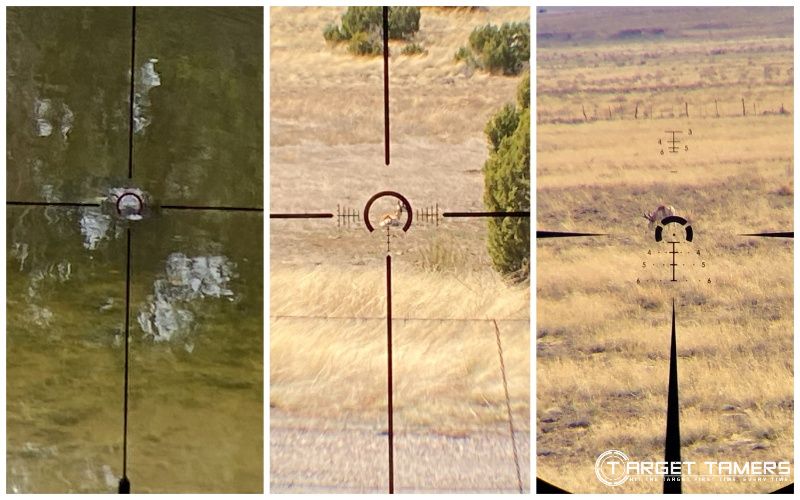
In general, the Strike Eagle 1-8x and the GLx 1-6x have reticles calibrated for the .223/5.56mm and .308 Win rounds. However, using a ballistics app can help to calculate what the holdovers are for your specific loads. With that said, the GLx ACSS Raptor M6 reticle provides longer range.
The M6 reticle has bullet drop out to 800 yards versus the 600 yards on the EBR-8.
Paper target @ 300 yards w/GLx (left) Antelope @ 333 yards w/SE (right) - Image by Tina Fa'apoi (Own Work) for Target Tamers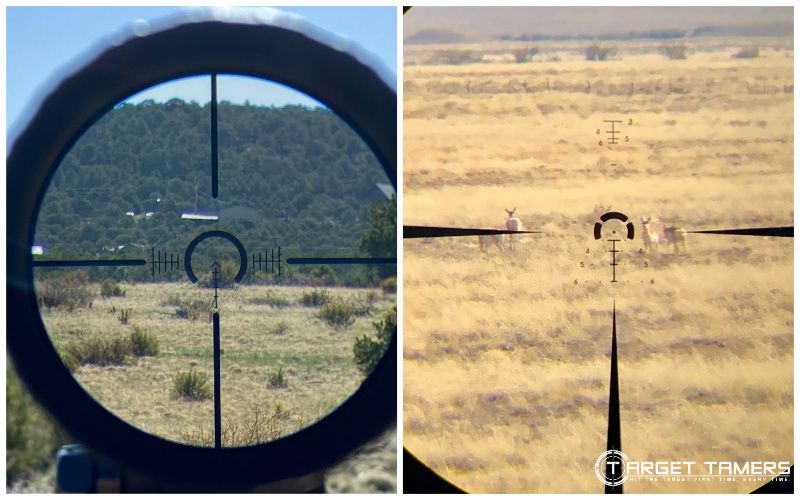
A cantilever mount is not typically included as an accessory with an LPVO scope save for bundle purchases and perhaps some budget scopes. Neither the Vortex Strike Eagle or the Primary Arms GLx FFP scopes come with an included cantilever mount. It must be purchased separately.
Vortex Sport Cantilever mount VS Primary Arms Deluxe AR-15 Cantilever mount - Image by Tina Fa'apoi (Own Work) for Target Tamers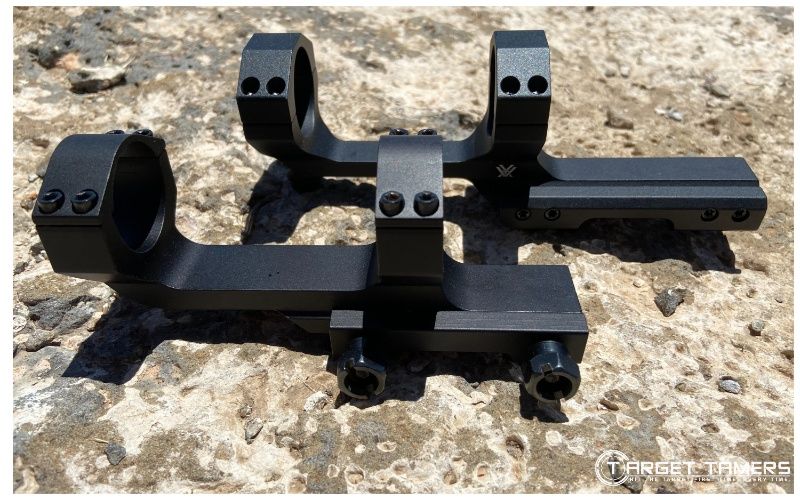
The Vortex Strike Eagle is made in China and the Primary Arms GLx is made in the Philippines. This is confirmed via the sticker and stampings on the underside of the scopes. Though Primary Arms have manufacturing facilities in China, the mid-tier GLx series is made in the Philippines.
Image by Tina Fa'apoi (Own Work) for Target Tamers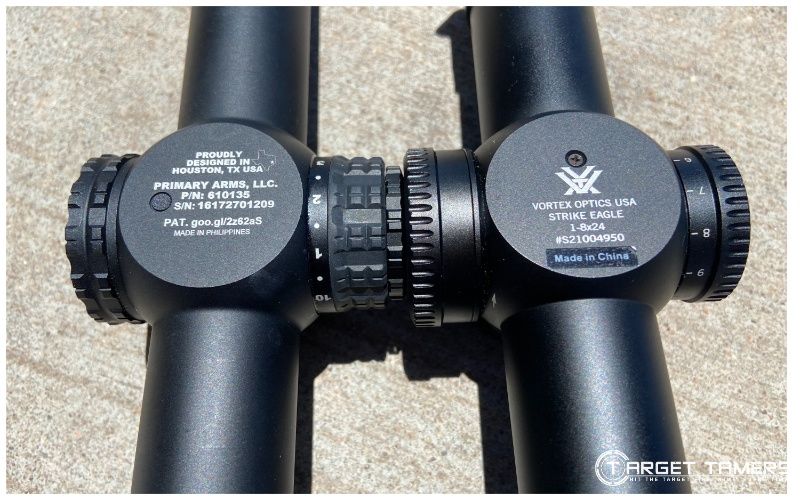
Though a CR2032 battery powers the illumination, the reticles in the Primary Arms GLx 1-6x FFP and the Vortex Strike Eagle 1-8x FFP scopes are glass-etched. They are black and highly visible in almost all settings. The scopes can be used even if the battery fails and there is no illumination.
GLx (left) SE (right) - Image by Tina Fa'apoi (Own Work) for Target Tamers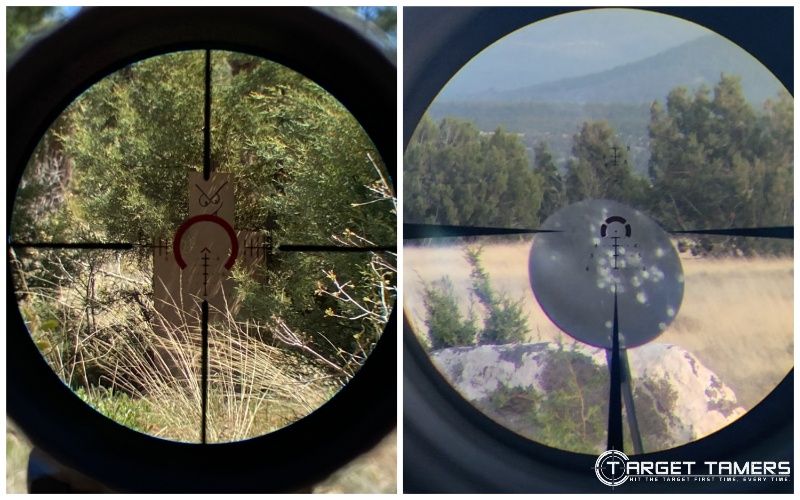
Vortex Strike Eagle VS Primary Arms GLx: Best LPVO?
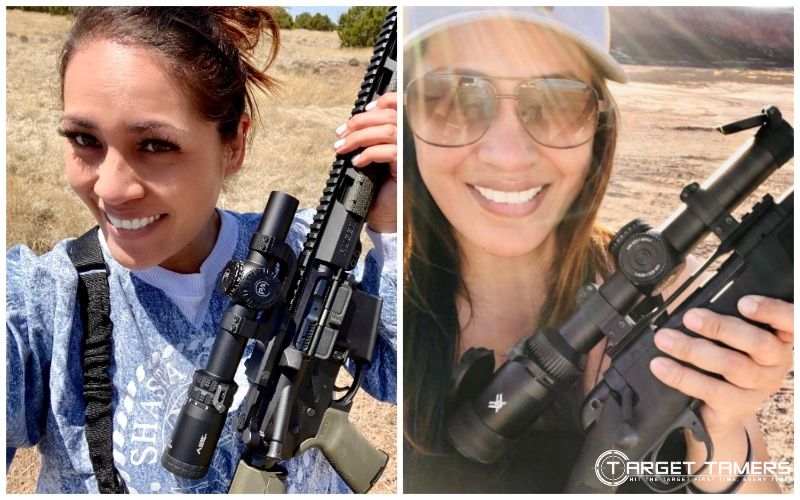
Overall, both the Vortex Strike Eagle 1-8x and the Primary Arms GLx 1-6x share many features from their glass-etched first focal plane scope (FFP) reticles to their excellent build quality. However, there are notable differences that gives the Primary Arms GLx LPVO an advantage in the field.
Both scopes are quality performers, but if you prefer simplicity and ease of use, the Vortex Strike Eagle LPV will suffice. If you want all the bells and whistles of a mid-tier LPVO, the Primary Arms GLx has it in abundance.
Further Reading



